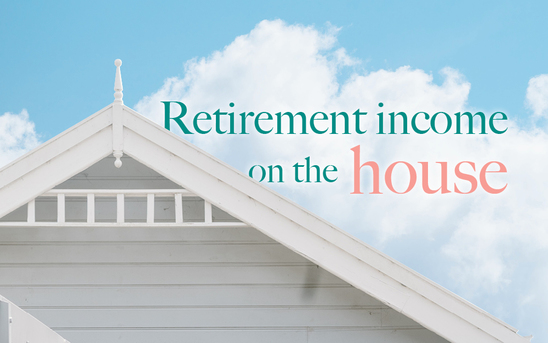Retirement income on the house

Asset rich and income poor is the dilemma faced by many retirees. But there may be opportunities to boost your income in retirement by tapping into your biggest asset – your home.
With property prices booming, many retirees are finding that the home they have lived in for decades is worth a small fortune, but for various reasons they don’t wish to sell or downsize.
What many may not realise is that you can have your cake and eat it too. Or, in this case, convert part of the value of your home into an income stream while you remain living there.
The ability to borrow against the equity in your home without having to repay until you move out or sell comes in various guises, but the result is largely the same – an enhanced lifestyle in retirement. The extra income may allow you to enjoy some little luxuries, travel more, or pay for home improvements.
There are four key types of product on offer:
- Reverse mortgage
- Home reversion
- Equity release agreement
- The government’s Pension Loans Scheme (PLS).i
None of these strategies should be adopted without careful consideration as they may have an impact on your family, your beneficiaries and – with the exception of the PLS – your Age Pension if you receive one.
As a result, we recommend you speak to us first to discuss whether accessing some of your home equity would be appropriate for you.
This is how these products work:
1. Reverse mortgage
A reverse mortgage lets you borrow money against the value of your home and take it as an income stream, a line of credit, a lump sum or a combination.
The amount you borrow is often determined by age. At 60 you can generally borrow 15-20 per cent of the value of your home. This percentage increases by 1 per cent a year.ii
The interest accrues and is paid when you sell, either on entering an aged care facility or from your estate when you die. The interest rate is usually higher than the standard mortgage rate, but you don’t have to make repayments along the way. Since 2012, reverse mortgages must come with a negative equity guarantee. This ensures you can never end up owing more than your home is worth.
2. Home reversion
Here you sell a percentage of the future value of your property at a reduced rate. It is not a loan, so there is no interest payable. However, there are immediate costs such as a property valuation and an upfront fee. And there is also the cost of losing the full benefit of your home’s increase in value over time. The more your home’s value increases, the more the provider will receive.
3. Equity release scheme
This third option lets you sell a percentage of the value of your home in return for a lump sum or an income stream. You pay fees which are periodically deducted from the remaining equity in your home, so your share diminishes over time.ii
4. Pension Loans Scheme
The Federal Government’s loan scheme is offered through Services Australia and the Department of Veterans Affairs.
You can access a voluntary non-taxable fortnightly loan up to 150 per cent of the maximum Age Pension rate to bolster your retirement income with the loan secured against your home. You don’t need to be on the Age Pension to qualify but even if you are, this government loan does not impact your pension entitlements.iv
Your mortgage increases by the payment amount plus interest which currently stands at 4.5 per cent a year. As with the other schemes, you don’t need to repay the loan until you move out or sell. And if your circumstances change, you can adjust the loan accordingly such as pausing payments.
All four options are variations on a theme of providing a better lifestyle in retirement.
If you want to find out if any of these options might play a role in your retirement income strategy, don’t hesitate to call us on 03 5120 1400 to discuss with our Financial Planning Team or via our website contact page.
Case study
Self-funded retirees Frank (75) and Mary (73) were struggling to maintain their lifestyle after no longer qualifying for the Age Pension. By borrowing $400 a fortnight against their $390,000 home from the government’s Pension Loans Scheme, they would still own 72 per cent of their property after 10 years and 41 per cent after 20 years. In the meantime, they can enjoy a few extra luxuries in life while remaining in their home. v
i https://moneysmart.gov.au/retirement-income/reverse-mortgage-and-home-equity-release
ii https://www.ratecity.com.au/home-loans/articles/maximum-amount-borrow-reverse-mortgage
iii https://moneysmart.gov.au/retirement-income/reverse-mortgage-and-home-equity-release
iv https://www.pensionboost.com.au/faqs
v https://www.pensionboost.com.au/pension-loan-scheme
Material contained in this publication is a summary only and is based on information believed to be reliable and received from sources within the market. It is not the intention of RGM Financial Planners Pty Ltd ABN 36 419 582 Australian Financial Services Licence Number 229471, RGM Accountants & Advisors Pty Ltd ABN 69 528 723 510 that this publication be used as the primary source of readers’ information but as an adjunct to their own resources and training. No representation is given, warranty made or responsibility taken as to the accuracy, timeliness or completeness of any information or recommendation contained in this publication and RGM and its related bodies corporate will not be liable to the reader in contract or tort (including for negligence) or otherwise for any loss or damage arising as a result of the reader relying on any such information or recommendation (except in so far as any statutory liability cannot be excluded).
Liability limited by a scheme approved under Professional Standards Legislation.
